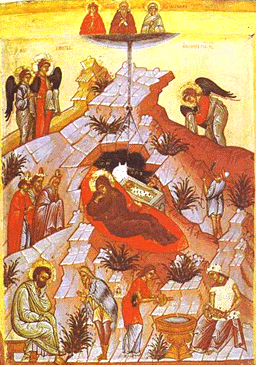...Best of Sicily presents... Best of Sicily Magazine. ... Dedicated to Sicilian art, culture, history, people, places and all things Sicilian. |
by Roberto Paglia | ||
Magazine Index Best of Sicily Arts & Culture Fashion Food & Wine History & Society About Us Travel Faqs Contact Map of Sicily |
Perhaps the best thing about spending Christmas in Sicily is that you don't have to trek off to a particular locality. Even the smallest towns have their own traditions, all essentially Christian in tone. Just seek out the chiesa madre (mother church) or cathedral in the old part of town to see the local interpretation of the Nativity. In Palermo alone a dozen churches offer scenes among the world's best. (Only Naples can be said to rival Palermo's.) Though we've pictured here an icon of the Nativity, the manger scene is a more common Christmas sight in Sicily. No misplaced Political Correctness here, where Christmas (Natale) is still Christmas, not some ridiculous "secular" (non-religious) holy day. Italy has no "generic" un-Christianized religious holidays. That's not to say that most Sicilians are Roman Catholic in anything more than name, but even many agnostics go to church on Christmas or Christmas Eve, and many of the religious practices are typically Sicilian. A favorite (and very "commercial") Italian Christmas treat nowadays is panettone, a rather bland bread cake, but it's not Sicilian and, truth be told, not even very traditional. The real Sicilian winter cake is something tastier called buccellato, a kind of big round cookie filled with almonds, pistachios, figs and other dried fruits, a little like Tuscan panforte or England's plum pudding except for the delicious crust. And real Sicilian eggnog (zabaglione) is made with Marsala wine. Contrary to widespread belief, torrone is not really a Christmas candy, but in Sicily it's sold in the cooler months when it is less likely to melt. Foreign visitors (especially Americans and Canadians, it seems) are sometimes surprised to see Christmas trees in Sicily. They became popular here during the Allied occupation (1943-1945). Artificial trees are what most people buy. Most of the small (live) pine trees sold in Palermo and Catania come from Germany or Austria, but a few specimens of the elusive, endangered Nebrodi Fir flourish in the Madonie and Nebrodi mountains. Traditionally, the feast of the Immaculate Conception (8 December) is when Italians erect, decorate or light Christmas trees. The Sicilian Christmas season begins unofficially in late November. This is not just a commercial trend --though that certainly exists in Italy-- but also an ecclesiastical one. For example, Monreale's annual holy music week of concerts in its splendid Byzantine cathedral takes place in November just before Roman Catholic "Advent." (the Christian season beginning with the fourth Sunday before Christmas Day). For most Italians, Saint Martin's Day (11 November) is too early to think about Christmas, and considered by many Sicilians to signal little more than cooler nights. People refer to "Saint Martin's Summer" if it is still summery in early November, and that is often the case. Christmas is a great time to visit Sicily. About the Author: Roberto Paglia has written several articles for this publication relating to social topics. | |
Top of Page |
 In a land boasting dozens of holidays and
traditional holy feasts, Christmas is still the most enchanting season.
Here in Sicily, it is perhaps as commercial as elsewhere, if slightly more
"low key." Officially, the season lasts from Christmas Eve (24
December) through the Epiphany (6 January). In Italy, the day after Christmas
(Saint Stephen's Day) is a national holiday, and so is the Epiphany. In
earlier times, children received gifts on the Epiphany rather than on Christmas
day itself. New Year's Eve is the feast of Saint Silvester, distinguished
in Italy for its multi-course cenone (a huge dinner). Saint Nicholas
Day (6 December) is a minor feast and not celebrated today as it was in
the past, but it occurs during the general Christmas Season, and so does the feast of the Immaculate Conception (8 December), a national holiday when banks and post offices are closed. Traditional
Italian things like Nativity scenes exist alongside Christmas trees. Except
for an occasional touch of snow in the mountains, it's all very Mediterranean.
In a land boasting dozens of holidays and
traditional holy feasts, Christmas is still the most enchanting season.
Here in Sicily, it is perhaps as commercial as elsewhere, if slightly more
"low key." Officially, the season lasts from Christmas Eve (24
December) through the Epiphany (6 January). In Italy, the day after Christmas
(Saint Stephen's Day) is a national holiday, and so is the Epiphany. In
earlier times, children received gifts on the Epiphany rather than on Christmas
day itself. New Year's Eve is the feast of Saint Silvester, distinguished
in Italy for its multi-course cenone (a huge dinner). Saint Nicholas
Day (6 December) is a minor feast and not celebrated today as it was in
the past, but it occurs during the general Christmas Season, and so does the feast of the Immaculate Conception (8 December), a national holiday when banks and post offices are closed. Traditional
Italian things like Nativity scenes exist alongside Christmas trees. Except
for an occasional touch of snow in the mountains, it's all very Mediterranean.